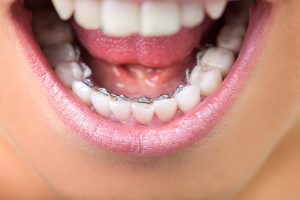Get The Smile You Want With Lingual Braces
Avoiding Tooth Decay During Independence Day
July 3, 2019What To Expect With An Infant Frenectomy
July 18, 2019
Lingual braces offer patients the opportunity to get the straight teeth they want without the look of traditional metal braces. Instead of brackets and wires on the frontside of teeth, lingual braces are placed on the backside of teeth to provide discreet and near-invisible treatment. Lingual braces correct long-term orthodontic issues just like traditional braces, but are more aesthetically pleasing. Find out how lingual braces work and whether they’re right for you with this guide!
Lingual Braces vs. Traditional Braces
Orthodontic patients have more options than ever to fix malocclusion and get the straight teeth they want, including what type of appliance they use for treatment. More than 3 million teenagers are currently using braces across the U.S., with millions of adults using them, as well. While traditional metal braces use brackets and wires that are attached to the frontside of teeth, lingual braces offer a nearly-invisible form of treatment in which the brackets and wires are attached to the backside (lingual) of teeth. For kids and teenagers, lingual braces give them their confidence and self-esteem back as they don’t have to worry about how they’ll look with bulky metal braces. Although they fulfill an aesthetic appeal, they’re also more functional than traditional braces as it is easier to play a wind instrument or a sport with them on. Lingual braces also produce the same results that traditional braces do: straight, healthy and beautiful teeth. If you’re looking for a more discreet method of orthodontic treatment for yourself or your child, lingual braces is the way to go.
Facts of Lingual Braces
Other than the fact that lingual braces provide treatment that is inconspicuous and undetectable, other perks of lingual braces include the correction of lifetime dental issues and increased self-esteem after treatment. People who are active in sports, especially contact sports, will find it easier to participate as they won’t need to wear a mouthguard anymore to cover the brackets on the frontside of their braces. Those who play wind instruments, such as flute, trumpet or saxophone, will find that it is easier to perform as the brackets and wires don’t get in the way like traditional braces do. However, for lingual braces to be attached correctly, your teeth will need to be long enough to provide sufficient room to glue the braces on them. For those with smaller teeth or young kids, lingual braces might not work as well. Additionally, treatment time may take longer for lingual braces than traditional braces, but it depends on your orthodontist and how well you care for them during the entire process.
One area of concern that families have about lingual braces is their cost. Traditional braces typically cost between $3,000-7,000 while lingual braces can cost upwards of $8,000-10,000. The price tag may seem quite heavy from an outside perspective, but many patients agree that the benefits of invisible and functional treatment that lingual braces provide are well worth the cost. If your child is under 18, dental insurance will partially cover them, especially if braces are deemed medically necessary. You can also buy supplemental orthodontic insurance if your insurance plan doesn’t cover braces, or you can deduct the dental health care costs in your taxes.
Oral Hygiene Tips
If you or your child is eligible for lingual braces, it is essential that you maintain a regular oral hygiene routine throughout treatment to keep your teeth free from tooth decay. Just like ordinary braces, food particles can easily get stuck between the brackets and wires of lingual braces, allowing plaque to form. Food also tends to be more difficult to remove when it’s stuck on the backside of teeth, so daily brushing and flossing will be necessary. Make sure to brush at a 45-degree angle to the gums, and brush in small circular motions. Brush up and down on each bracket, and floss underneath the wire connecting the brackets to remove leftover food. You might even consider using a fluoride mouthwash after brushing and flossing to prevent white spots from developing and cavities from forming.
The best thing that you can do for your oral health is be consistent. Watching what foods you eat while brushing and flossing daily will prevent the majority of dental issues that could occur during orthodontic treatment. Committing to a good oral hygiene routine before treatment will help you develop a good routine throughout the process and after it’s completed.
Scheduling An Appointment
Before you can be fitted for lingual braces, you will need a consultation and evaluation by an orthodontist to determine if it is your best option. If you are interested in lingual braces, call Hardy Pediatric Dentistry & Orthodontics today at (720) 887-6003 to schedule a consultation. We are dedicated to your family’s oral health needs and experienced in helping patients everywhere get the beautiful smiles that they deserve. Call today to start your journey towards a brilliant, healthy smile!